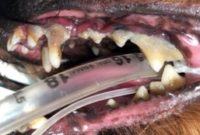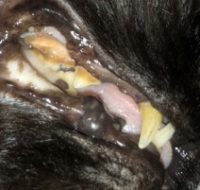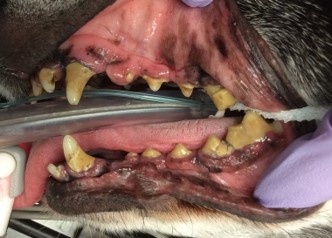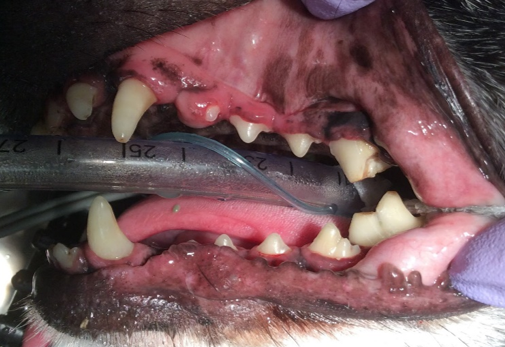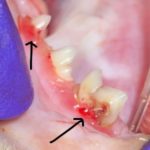According to the American Veterinary Dental Society, 80% of canines and 70% of felines begin showing signs of oral disease before the age of 5. There is no doubt that maintaining our pets’ oral hygiene can be a challenge, requiring involvement of both owners and veterinary staff.
Day to day, teeth develop a soft film called plaque. If allowed to accumulate, it hardens into a substance called calculus (also called tartar). Once hardened, simple brushing is not enough to remove calculus. In early stages of dental disease, the calculus harbors bacteria and causes gingivitis. Eventually, inflammation and bacteria cause damage to the structural integrity of the teeth.
In later stages of periodontal disease, soft tissues surrounding the teeth are destroyed and the bony socket erodes, leading to tooth mobility or loss and sometimes infection or abscess. Even more concerning, as the soft tissues of the gums become compromised, bacteria has a way to enter the bloodstream and travel to vulnerable organs potentially causing heart disease, kidney disease, lung disease, and more.
Once calculus has hardened, removal requires veterinary intervention. Dental cleanings should be performed under full anesthesia, and your veterinarian will be able to assess your pet’s individual treatment plan. During the procedure, a technician will scale (clean) and polish their teeth, take digital radiographs, and apply a barrier sealant (if requested). The veterinarian performs a full oral exam, probes each tooth for bone loss, reviews the x-rays, and extracts any tooth that has significant structural damage or the potential for future complications. They will then review with you the best treatment plan going forward, but most pets will benefit from preventative care at home.
- Before Dental Cleaning
- After Dental Cleaning
There are several ways to help care for your pets’ oral health at home:
- Teeth brushing with a small soft bristled brush and animal-specific toothpaste
- Treats designed for dental hygiene like Oravet chews, Greenies, or CET chews
- Oral rinses or water additives
- Hill’s T/D food which encourages chewing and physically scrapes the surface of the teeth
- Avoiding chews like bones, antlers, or hooves. Even though these are available in pet stores, they are too hard and can break teeth
Cats may have several additional periodontal issues. More than half of cats older than 3 years old have feline oral resorptive lesions (FORLs). These occur when the root of the tooth erodes and is turned into bone. These can be very painful, sometimes to the point where the cat is reluctant to eat. While we don’t exactly understand what causes FORLs, extracting the affected tooth will prevent further discomfort. Cats can also get stomatitis. This is believed to be an auto-immune disorder where the cat’s body mounts a defense against their own tartar. Affected cats will have bad breath and difficulty eating. Stomatitis does not have an easy cure, but extraction of most or all of their teeth can significantly improve their comfort.


